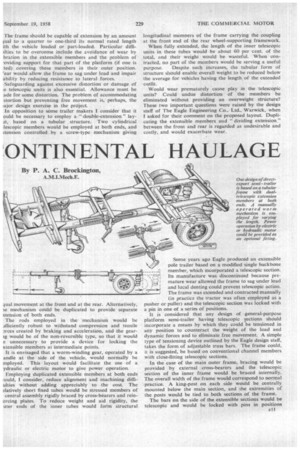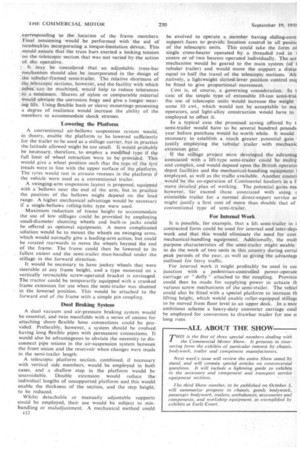ONTIN ENTAL HAULAGE
Page 97

Page 98

If you've noticed an error in this article please click here to report it so we can fix it.
4ual movement at the front and at the rear. Alternatively, le mechanism could be duplicated to provide separate xtension of both ends.
The rods employed in the mechanism would be Anciently robust to withstand compression and tensile 3rces created by braking and acceleration, and the gearig would be of the non-reversible type, so that it would e unnecessary to provide a device for locking the xtensible members at intermediate points.
It is envisaged that a worm-winding gear, operated by a andle at the side of the vehicle, would normally be mployed. This layout would facilitate the use of a ydraulic or electric motor to give power operation. Employing duplicated extensible members at both ends rould, I consider, reduce alignment and machining diffiulties without adding appreciably to the cost. The elatively short fixed tubes would be stressed members of central assembly 'rigidly braced by cross-bearers and reinorcing plates. To reduce weight and aid rigidity, the uter ends of the inner tubes would form structural Some years ago Eagle produced an extensible pole trailer based on a modified single backbone member, which incorporated a telescopic section. Its manufacture was discontinued because premature wear allowed the frame to sag under load and local denting could prevent telescopic action. The frame was extended and contracted manually (in practice the tractor was often employed as a pusher or puller) and the telescopic section was locked with a pin in one of a series of positions.
It is considered that any design of general-purpose platform semi-trailer having telescopic sections should incorporate a means by which they could be tensioned in any position to counteract the weight of the load and dynamic forces and to eliminate free movement. A simple type of tensioning device outlined by the Eagle design staff, takes the form of adjustable truss bars. The frame could, it is suggested, be based on conventional channel members with close-fitting telescopic sections.
In the case of the main outer frame, bracing would be provided by external cross-bearers and the telescopic section of the inner frame would be braced internally. The overall width of the frame would correspond to normal practice. A king-post on each side would be centrally. mounted below the main section, and the extremities of the posts would be tied to both sections of the frame.
The bars on the side of the extensible sections would be telescopic and would be locked with pins in positions
,corresp.onding to the location of the frame members. Final tensioning would . be performed with the aid of turnbuckles incorporating a torque-limitation device. This would .ensure that the truss bars exerted a locking, tension on the telescopic section that was not varied by the action of the operative.
It may_ be considered. that an adjustable truss-bar mechanism should also be incorporated in the design of the tubular framed semi trailer The relative shortness of the telescopic sections, however, and the facility with which tubes can be machined, would help to reduce tolerances to a minimum. Sleeves .01 nyton or comparable material
• would obviate the corrosion bogy and give a longer_ wearing life. Using flexible bush or sleeve mountings possessing a degree of resilience would increase the ability of the members to accommodate shock stresses.
Lowering the Platform
A conventional . air-bellows suspension system would, in theory, enable the platform to be lowered sufficiently for the trailer to be used as a stillage carrier, but in practice the latitude allowed might be too small. It would probably be necessary, therefore, to employ a modified type if the full limit of wheel retraction were to be provided. This would give a wheel position such that the tops of the tyre treads were in line with the upper surface of the platform. The tyres would rest in arcuate recesses in the platform if the vehicle were used as a conventional trailer.
A swinging-arm suspension layout is proposed, equipped with a 'bellows near the end of the arm, but in' practice. the position of the bellows might depend on the load range. A higher mechanical advantage would be necessary if a single-bellows rolling-lobe type were used.
Maximum reduction of frame height to accommodate the use of low stillages could be provided by employing small-diameter shunting wheels and built-in jacks could be offered as optional equipment. A more complicated solution would be to mount the wheels on swinging arms. which would normally give a leading-arm action, but could be rotated rearwards to move the wheels beyond the end of the frame. The frame could then be lowered to its fullest extent and the semi-trailer, man-handled under the stillage in the forward direction.
It would be necessary to have jockey wheels that were steerable at any frame height, and a type mounted on a vertically retractable screw-operated bracket is envisaged. The tractor could be temporarily equipped with a cranked frame extension for use when the semi-trailer was shunted in the lowered position. This would be attached to the forward end of the frame with a simple pin coupling.
Dual Braking System
A dual vacuum and air-pressure braking system would be essential, and twin manifolds with a series of unions for attaching short. flexible hose connections could be provided. Preferably, however, a system should be evolved having long flexible pipes with permanent connections, It would also be advantageous to obviate the necessity to disconnect pipe unions in the air-suspension system between the front union and the reservoir when changes were made in the semi-trailer length.
A telescopic platform section, combined, if necessary with vertical side members, would be employed in both cases, and a shallow step in the platform would be unavoidable. Double extension would reduce the individual lengths of unsupported platform and this would enable the thickness of the section, and the step height, to be reduced.
Whilst detachable or manually adjustable supports could be employed, their use would be subject to mishandling or maladjustment. A mechanical method could El 2
be evolved to operate a member having sliding-cont support faces to' provide location control in all positk of the telescopic units. This could take the form of single cross-bearer operated by. a threaded rod in centre or of' two bearers operated individually. The scr mechanism would be geared to the main system (of tubular trailer) and would move the support a distar equal to half the travel of the telescopic sections. 'Alt natively, a lightweight slotted-lever position control mit he fitted to give proportional movement.
Cost is, of course, a governing consideration. In t case of the simple type of extensible 10-ton semi-trai the use of telescopic units would increase the weight some 10 cwt., which would not be acceptable to ma operators, and light-alloy construction would have to employed to offset it.
In a typical case the promised saving offered by t semi-trailer would have to be several hundred pounds year before purchase would be worth while. It would necessary to establish a much greater potential gain justify employing the tubular trailer with mechanic extension gear.
If the stillage project were developed the advantag associated with a lift-type semi-trailer could be multip and complex, and would depend upon the British operatoi depot facilities and the mechanical-handling equipment 1 employed, as well as the traffic available. Another essenti would be the co-operation of Continental hauliers in a f more detailed plan of working. The potential gains ma however, far exceed those associated with using E extensible trailer for a normal direct-export service ar might justify a first cost of more than double that of conventional type of semi-trailer.
For Internal Work
It is possible, for example, that a lift semi-trailer in i contracted form could be used for internal anclinter-dept work and that this would eliminate the need for cost mechanical-handling equipment. Additionally, the milt purpose characteristics of the semi-trailer might enable to do the work of two units in this country during certai peak periods of the year, as well as giving the advantagt outlined for ferry traffic.
For internal work it might profitably be used in car junction with a pedestrian-controlled power-operate carriage or " dolly " attached to the coupling. Provisio could then be made for supplying power to actuate th various screw mechanisms of the semi-trailer. The vehicl could also be fitted with a special platform to increase th lifting height, which wolild enable roller-equipped stillagE to be moved from floor level to an upper deck. In a mor ambitious scheme a heavy-duty converter carriage coul be employed for conversion to drawbar trailer for use o long runs.
















































































































































































































